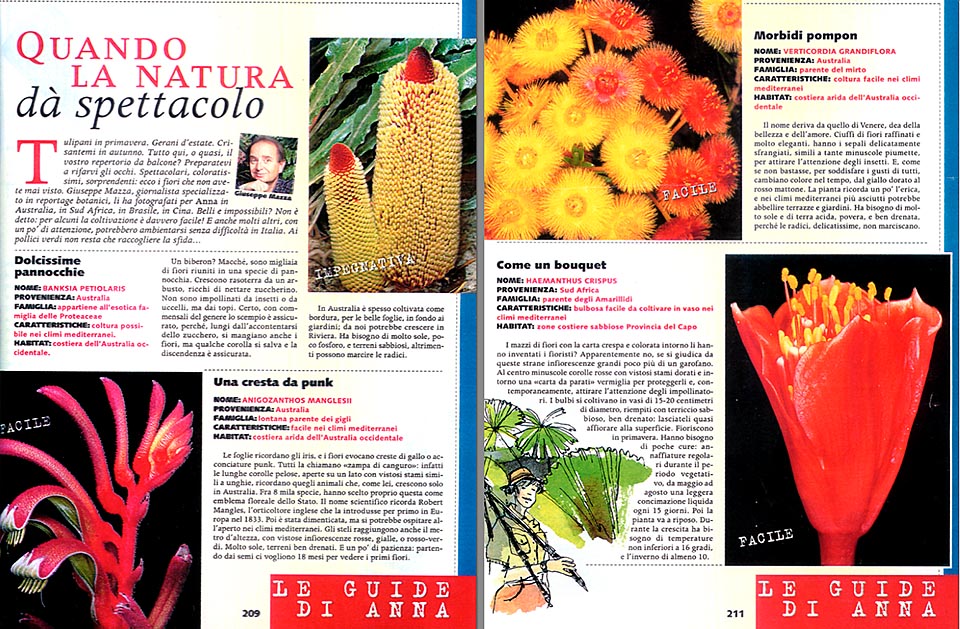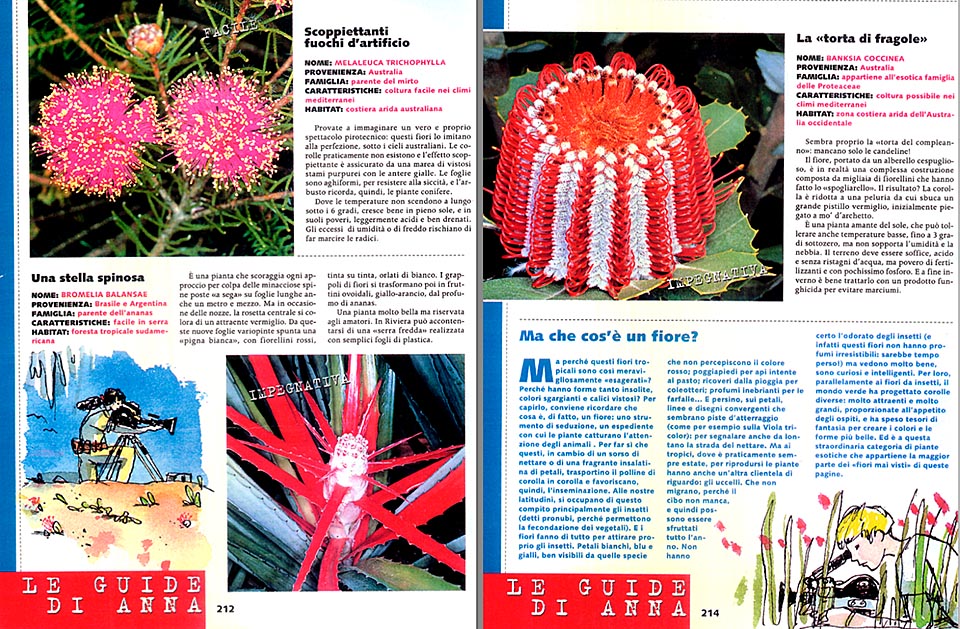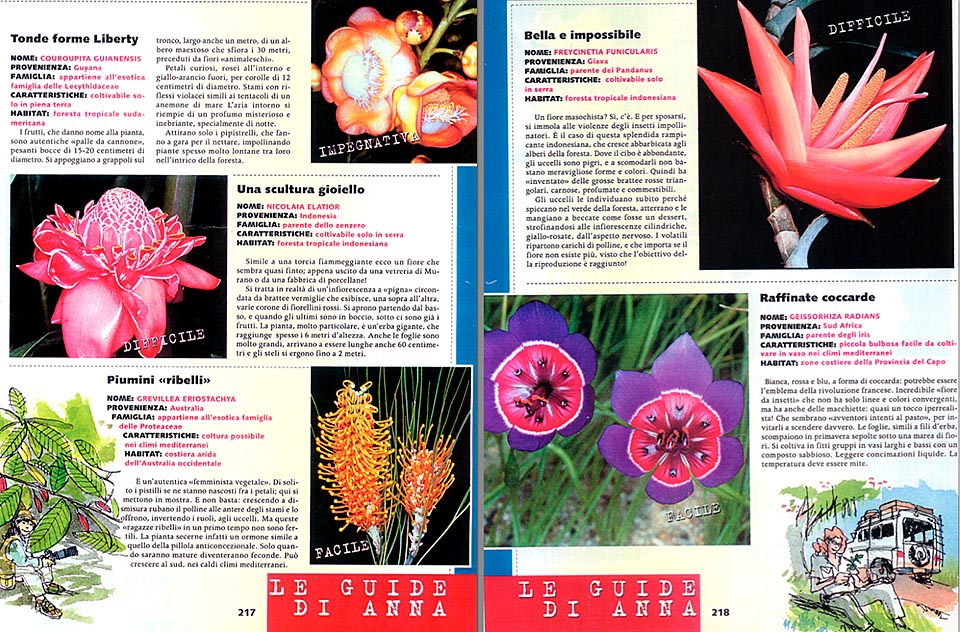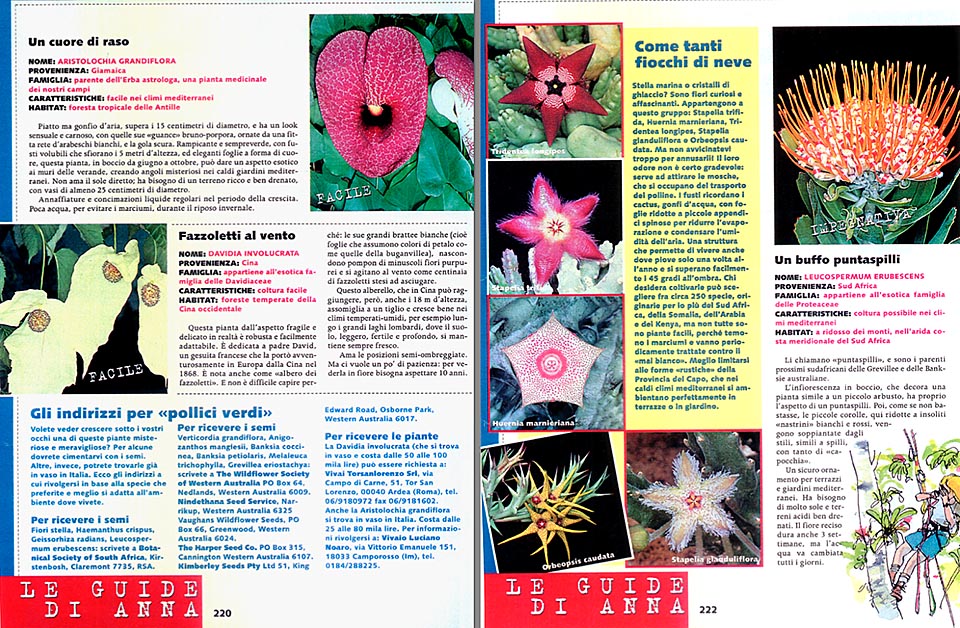When nature gives show.





Text © Giuseppe Mazza

English translation by Mario Beltramini
The flowers, what are they?
By sure, not machines done for seducing the Green World, which has no eyes, and where females choose their partners among different granules of pollen with complicated hormonal systems, but instruments for getting in touch with the animals, which, attracted by the forms, the colours and the scent, take care of transporting the pollen, in exchange of a sip of nectar, or of fragrant “small salads”, of petals.
In our regions, it is mainly the insects which work hard; and the flowers have done all they could to adapt to these pollinators. White, blue, and yellow petals to satisfy those which cannot perceive the red; footrests for bees and bumble-bees, intent upon their meal; shelters from the bad weather for coleoptera; inebriating scents for butterflies; and, often, modern “landing strips”, with converging lines and drawings, which reveal at once, from far away, the road to the nectar.
But in the Tropics, where it is summer almost always, the plants have also other customers: the birds. Where the food is not missing, these ones do not migrate, and then can be exploited all the year round. By sure, they do not hold the sense of smell as the insects, and, therefore, it is a waste of time to elaborate scents, but they have a very good eyesight, have an undoubted curiosity and intelligence.
For them, likewise the “insect flowers”, the Green World has designed different corollas and inflorescences, of large size, proportionate to the unappeasable appetite of the guests, and has spent treasures of fantasy to create the colours and the most beautiful forms. And it is to this category of exotic winking plants, that belongs the majority of the “never seen” plants.
BANKSIA PETIOLARIS
Australia – It belongs to the exotic family of the Proteaceae – Cultivation possible in Mediterranean climate.
A feeding bottle? Certainly no, they are thousands of flowers gathered together in a sort of a panicle. They grow up, close to the ground, from a shrub, rich of sugary nectar. They are not pollinated by insects or birds, but by mice.
By sure, with such table companions, the havoc is sure, as, far from contenting themselves of the sugar, they eat also the flowers; but some corollas save themselves, and so the progeny is guaranteed.
In Australia, it is often cultivated as border plant, due to the nice leaves, in the back of the gardens; in our country, it might grow up in the Riviera. It needs of a lot of sun, little phosphorus, and sandy soils. It fears the rottenness on the roots.
ANIGOZANTHOS MANGLESII
Australia – Distant relative to the lilies – Easy in Mediterranean climates.
The leaves recall the irises, and the flowers evoke crests of cocks or Punk hair-dos. Seen, however, that the plant grows up only in Australia, it has assumed the name of “Kangaroo paw”, for some long hairy corollas, open on a side, with showy stamens similar to nails.
It has been chosen, between 8.000 species of Western Australia, as floral symbol of the State, and the scientific name recalls Robert Mangles, the English horticulturist who, starting from the seeds, introduced it, for the first, in Europe, in 1833.
Then, it has fallen into oblivion; but it could be kept in open air in the Mediterranean climates. The stems can reach even the height of a metre, with showy red, yellow, or red-green inflorescences. Much sun, poor soils, and well drained. If we start from the seeds, we need then about 18 months to see the first flowers.
VERTICORDIA GRANDIFLORA
Australia – Relative of the myrtle – Easy in Mediterranean climates.
The name, not by chance, is connected to Venus, goddess of beauty and love. The refined style of the flower comes from the sepals, finely laciniated like a feather, to attract the attention of the insects.
And, as though it should not suffice, they change of colour with the time, from gold yellow to brick red, in order to please all tastes.
The plant somewhat recalls the heath, and in the Mediterranean climates, it could decorate terraces and gardens. I need lot of sun and acid, poor, well drained, soils, in order to avoid rottenness to the roots.
HAEMANTHUS CRISPUS
South Africa – Relative of the Amaryllidaceae – A bulbous plant easy to cultivate in vase in Mediterranean climates.
Did florists invent the bunches of flowers wrapped in paper? Seemingly, not, if we consider these strange inflorescences, a little more bigger than a carnation. At the centre, small red corollas with showy golden stamens, and, around, a vermilion “wall paper”, to protect them and attract the glances of the pollinators.
The bulbs are cultivated, almost at the surface of the soil, in pots of 15-20 cm., and a sandy, well drained, compound. They bloom in spring. Regular watering during the vegetative period. From May to August, a light liquid manuring every 15 days. Then, the plant reposes. During its growth, it needs lowest temperatures not inferior to 16°C, and, in winter, of at least 10°C.
Australia – Relative of the myrtle – Easy in Mediterranean climates.
Do you remember the fireworks? These “sexist flowers”, all sex, imitate them under the Australian skies. Practically, the corollas do not exist, and the pyrotechnical effect is ensured by a stream of showy purple masculine organs with the yellow anthers.
The leaves are needle-shaped, in order to resist to the drought, and the shrub somewhat recalls the conifers.
It grows well in full sun, and poor soils, slightly acid and well drained, where the lowest temperatures do not drop down, for long time, under the 6°C. The excesses of water cause rottenness to the roots.
Brazil-Argentina – Relative of the pineapple – Easy in greenhouse? Normally, it’s a plant which could not be noticed, should not it be for the terrible thorns placed, “saw-like”, on leaves long even one metre and a half, which discourage every approach.
But at the time of marriage, it colours of vermilion the central rosette; and from these new many-coloured leaves, comes out a “white cone”, with small red flowers, hemmed of white. In order not to deny the relationship, these ones then transform in ovoid, yellow-orange small fruits, with a scent of mine apple.
A plant for lovers, not too much advisable, which in Riviera, contents of a “cold greenhouse”, realized with simple plastic sheets.
Australia – It belongs to the exotic family of the Protaceae – Possible cultivation in Mediterranean climates.
It looks like a “birthday cake”, and only the small candles are missing!
The flower, carried by a bushy sapling, is actually formed by thousands of small flowers, which have done the “strip-tease”, reducing the corollas to a down, from where rises, obscene, a huge female organ, vermilion, initially bent like a bow.
It is a plant which loves the sun, but tolerates low temperatures till -3°C, but does not stand the humidity and the fogs. The soil, soft, acid and well drained, must be poor of fertilizers, with very little phosphorus. And, by the end of winter, it is a good thing to treat it with a fungicide, to avoid rottenness to the roots.
Guyana – It belongs to the exotic family of the Lecythidaceae – Can be cultivated only in greenhouse.
The fruits, which give the name to the plant, are the “Cannon balls”, heavy bowls of 15-20 cm. of diameter.
They rest in clusters on the trunk, even one metre wide, of a majestic tree, tall almost 30 metres, and are preceded by “animal-like” flowers.
Leathery petals, rosy inside, and yellow-orange externally, for corollas of 12 cm. of diameter. Stamens with purple reflexes, similar to the tentacles of a sea anemone, and a scent, mysterious and intoxicating, especially by night.
They attract only the bats, which compete for the nectars, pollinating plants often distant in the tangle of the forest.
NICOLAIA ELATIOR = ETLINGERA ELATIOR
Indonesia – Relative of the ginger – Can be cultivated only in greenhouse.
Similar to a “blazing torch”, the flower, at sight, seems fictitious; as coming from the shop of a glass-maker of Murano, or from a china-ware factory.
In reality, it is a “cone-like” inflorescence, surrounded by vermilion bracts, which carries, one on top of the other, several crowns of small red flowers. They open starting from the bottom, and when the last ones are in bud, those down below have already the fruits.
The plant, out of the ordinary too, is a gigantic grass, which reaches the 6 metres of height, with 60 cm. leaves, and stems long up to 2 metres.
Australia – It belongs to the exotic family of the Proteaceae – Possible cultivation in Mediterranean climates.
It is a genuine “vegetable feminist”. Usually, the pistils, the feminine organs of the flowers, hide modestly between the petals; here, seen that, practically, the corolla is absent, they show themselves impudently.
And this is not enough: growing up excessively, they deflower the masculine organs, rob the pollen to the anthers, the testicles of the plant; and offer the same, reversing the roles, to the birds.
Self-fecundation? Incest? No, because these rebel girls in a first time are not receptive, assume a sort of “pill”, and only when old, after having dispersed all the pollen, become fertile, thus resuming the maternal functions in accordance with the laws of nature.
It could grow up in the South, in the warm Mediterranean climates, but requires a lot of sun, little phosphorus, and sandy grounds.
FREYCENITIA FUNICULARIS
Java – Relative of the Pandanus – Beautiful and impossible – Only in greenhouse.
A masochist flower? Yes, that’s it. And, to get married, sacrifices itself to the violences of the pollinators.
This is the case of this splendid Indonesian climbing plant, which grows up clung to the trees of the forest. The birds are lazy where the food abounds, and the forms and colours are not sufficient to bother them. Therefore, it has invented large, red, triangular, pulpy, perfumed and edible bracts. The birds see them at once, against the green colour of the forest, land, and consume them, pecking, like a dessert, rubbing themselves against the cylindrical inflorescences, yellow-rosy, with a nervous look.
They leave, loaded of pollen, and who cares if the flower does not exist any more, seen that the aim of the reproduction has been attained?
GEISSORHIZA RADIANS
South Africa – Relative of irises – Small bulbous plant easy to cultivate, in vase, in Mediterranean climates.
White, red and blue, like a cockade, could be the symbol of the French Revolution! Incredible “insect flower”, which does not limit itself to converging lines and colours, but carries, like some advertising posters, also some dots, drawings of “customers intent on the meal”, to invite them to come down.
The leaves, similar to blades of grass, disappear in spring under a crowd of flowers. It is cultivated in thick groups, in small lawns, in wide and low vases with a sandy compound. Light liquid manuring during the vegetative effort, and lowest temperature over the 10°C.
ARISTOLOCHIA GRANDIFLORA
Jamaica – Relative of the “Erba astrologa”, a medicinal plant of our fields – Easy in Mediterranean climates.
The pendulous flower cannot be conducted to any scheme.
Flat, but inflated of air, has more than 15 cm. of diameter, and has a look definitely alarming, with its brown purple “cheeks”, adorned of thick net of white arabesques, and the dark throat, with an odd, yellow-cream, “clapper”.
Climbing and evergreen of the Antilles, with voluble stalks, which are very close to the 5 metres of height, and elegant heart shaped leaves, this plant, in bud from June to October, can give an exotic look to the walls of the veranda, creating mysterious corners in the warm Mediterranean gardens.
Does not love the direct sun, and needs a rich and well drained soil, with vases of at least 25 cm. of diameter.
Regular watering and liquid manuring during the vegetative period. Little water, to avoid rottenness, during the winter rest.
DAVIDIA INVOLUCRATA
China – It belongs to the exotic family of the Davidiaceae (currently, in 2018, belongs to the Cornaceae family) – Easy cultivation .
Dedicated to Father David, a French Jesuit who brought it, adventurously, in Europe from China, in 1868, this plant is also known as “Handkerchief tree”.
Its large, white bracts, which hide pompons of small purple flowers, in fact, wave in the wind like hundreds of scarfs, spread to dry up.
This small tree, which in China reaches the 18 metres of height, has leaves which resemble to a lime-tree, and grows well in temperate- humid climates, for instance, along the great Lombard lakes, where the soil, light, fertile and deep, remains always cool.
It loves mid-shaded positions, and flowers only starting from the tenth year of age.
STAR FLOWERS (STAPELIA TRIFIDIA, HUERNIA MARNIERIANA, TRIDENTEA LONGIPES, STAPELIA GLANDULIFLORA, ORBEOPSIS CAUDATA)
The flower, fleshy and somewhat alarming, looks like a starfish.
When we smell it, convinced to find an inebriating scent, we risk to jump backwards, because it often exhales a strong stench of rotten fish or putrescent meat.
It serves to attract the flies, which take care of the transportation of the pollen; but, luckily, about the 20% of this species entrusts the offspring to the gnats, and has therefore opted for pleasant scents of apples, bananas, or ripe fruits.
The stalks recall the cacti, swollen of water, with leaves reduced to more or less evident and thorny appendices, to reduce the evaporation and condensate the humidity of the air. A structure which allows to live where it rains, optimistically, once a year, and the temperature can easily be more than 45°C, in the shade.
Those who love them, can choose between about 250 species, mostly native of South Africa, Somalia, Arabia and Kenya, but they are not “easy plants” to cultivate, as they do not like rottenness and must be periodically treated against the oidium.
Better to limit oneself to the “rustic” forms of the Region of the Cape, which, in the warm Mediterranean climates, acclimatize sometimes perfectly in open air, in small “poaches”, well drained, in the rocky gardens.
South Africa, behind the mountains, in the arid “Fynbos” of the southern coast – It belongs to the exotic family of the Proteaceae – Possible cultivation in the Mediterranean climates.
They call them “pincushions”, and they are close South African relatives of the Grevillea and of the Australian Banksias.
The inflorescence in bud, carried by small shrubs or saplings, has indeed the appearance of a pincushion. Then, if this would not be enough, the small corollas, here reduced to odd, small white and red “small bands”, are replaces by the styles, similar to pins, with even the “heads”, as in grandma’s good old times.
A sure ornament for terraces and Mediterranean gardens, which lasts even 3 weeks in pot, as cut flower. It needs a lot of sun, and arid, well drained grounds.
ANNA – 1993
